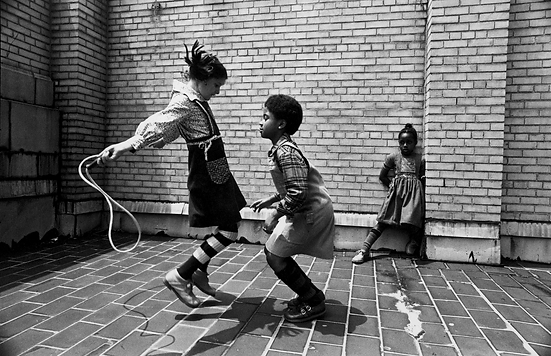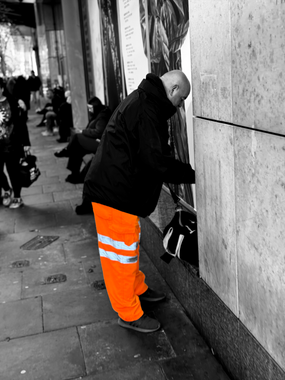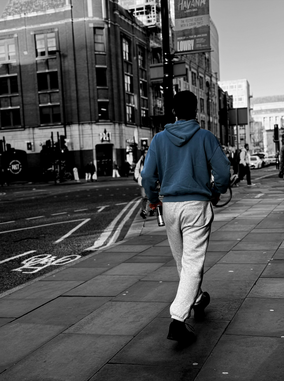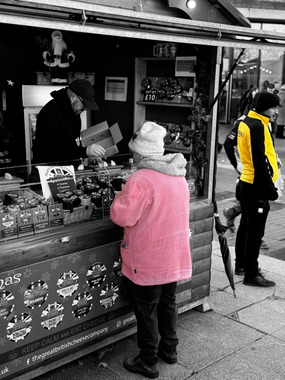JILL FREEDMAN
"I hate cheap pictures. I hate pictures that make people look like they're not worth much. Just to prove a photographers point.I hate when they take a picture of someone picking their nose or yawning.Its so cheap.A lot of its a big ego trip you use people as props instead of as people."



IMAGE ANALYSIS


This black-and-white photograph by Jill Freedman captures a spontaneous and joyous moment of childhood, embodying her signature documentary style that focuses on everyday life and human connection. The image portrays three young girls playing jump rope in an urban setting, framed by a brick wall that adds texture and depth to the composition.
The two girls in the foreground are fully engaged in their game—one mid-air with her braids flying, the other poised to jump, her expression concentrated. A third girl, slightly apart from the action, leans against the wall, observing, her body language suggesting curiosity or quiet anticipation. The photograph conveys a strong sense of movement and energy, enhanced by Freedman’s use of contrast and natural light.
Freedman was known for capturing intimate and unfiltered moments of life on the streets, particularly in working-class and marginalised communities. This image is a testament to her ability to highlight the beauty in everyday interactions, revealing the resilience, joy, and camaraderie of childhood despite any socio-economic hardships. The photograph also speaks to themes of innocence, play, and the universal nature of human connection—an aspect that defined much of Freedman’s work.
This photo by Jill Freedman captures a young girl standing confidently in the foreground, her bright smile and open stance exuding joy and playfulness. Behind her, a sign reading NOTHING BUT SOUL
sets the tone for the image, reinforcing themes of culture, identity, and community. In the background, seated and standing figures add depth to the scene, hinting at a larger social gathering or celebration.
Freedman’s work often focused on the lives of everyday people, particularly in marginalised communities, and this image reflects her ability to highlight both individuality and collective spirit. The photograph portrays a moment of unguarded happiness, emphasising the strength and pride of Black culture.
The contrast between the carefree innocence of the child and the powerful message in the background creates a compelling narrative about resilience, heritage, and self-expression.This image is a testament to Freedman’s skill in capturing the vibrancy of street life with authenticity. It not only documents a specific time and place but also conveys a universal sense of joy and empowerment, making it a striking example of her documentary photography.


This black-and-white photograph by Jill Freedman captures a candid moment of childhood play, illustrating themes of innocence, joy, and community. Two young girls are engaged in a game of jump rope, their bodies frozen in motion—the jumper in mid-air, her braids lifted by the movement, while the other girl focuses intently on her turn. A third child leans against the brick wall in the background, watching, perhaps waiting for her chance to join in.The strong composition, with the geometric patterns of the brick wall and tiled floor, emphasizes the energy and movement of the scene. The contrast between light and shadow enhances the depth of the image, drawing attention to the expressions and body language of the children.
Freedman’s work often highlighted everyday moments in urban life, particularly among marginalised communities. This image portrays a sense of resilience and freedom found in simple pleasures, despite any social or economic hardships that may exist beyond the frame. It speaks to the universality of childhood, where joy can be found in the most ordinary places.By capturing this fleeting moment, Freedman reminds viewers of the beauty in spontaneity and the power of human connection, reinforcing her ability to document life with authenticity and emotional depth.
This black-and-white photograph by Jill Freedman is a powerful example of her documentary style, capturing the daily lives of working-class individuals in an urban setting. Freedman’s work often focused on marginalised communities, highlighting moments of resilience, dignity, and camaraderie.The photograph features three men in work clothes standing and sitting around what appears to be an outdoor market stall or a workspace.
The man in the foreground leans confidently against the table, wearing a slightly worn jumpsuit with a pocket marked by initials, possibly identifying his workplace. His relaxed posture, direct gaze, and slight smile contrast with the more subdued body language of the other two men, who are either looking away or absorbed in their own thoughts.
Freedman’s use of a wide-angle lens creates a slightly distorted, immersive effect, making the viewer feel as though they are part of the scene. The curvature of the edges suggests the use of a vignette effect, drawing attention toward the central figure. The perspective adds depth, leading the eye from the sidewalk into the layers of the photograph—the street, the storefronts, and the men in their different positions.The black-and-white tones emphasise textures: the rough pavement, the worn fabric of the men’s clothing, and the various surfaces in the background.
The contrast between light and shadow adds depth, reinforcing the sense of realism and immediacy.This photograph captures themes central to Freedman’s work: labor, race, dignity, and urban life. The men’s clothing and body language suggest they are working-class labourers, possibly street vendors, construction workers, or factory employees. Their expressions and relaxed postures imply a break from work, a fleeting moment of rest or casual conversation.
The central figure’s confident stance and slight smile communicate a sense of pride and resilience, despite the likely hardships of his profession. The other two men, though less engaged with the camera, contribute to the overall mood—one walking past, seemingly lost in thought, and the other sitting pensively on the edge of the table. Their presence together suggests community and shared experience.Jill Freedman’s photography often documented the struggles and triumphs of working-class people, particularly in urban America during the mid-to-late 20th century.
The storefronts in the background suggest a neighbourhood where small businesses and street markets played an essential role in daily survival.The era during which Freedman worked was marked by racial and economic tensions, particularly in cities where segregation and poverty limited opportunities for Black workers. However, rather than portraying struggle alone, this photograph highlights camaraderie, quiet strength, and perseverance. It presents a narrative that is not defined by hardship but by the resilience and character of the individuals within it.
Her work serves as an important historical record of working-class life, particularly among Black communities in American cities. This photograph, like much of her work, speaks to the universality of human experience—work, friendship, resilience, and the quiet moments in between.
Many of her photographs focused on racial and economic inequalities, yet she always captured her subjects with dignity rather than pity.This image may have been taken in a city such as New York, where Freedman spent much of her career documenting street life, or in another urban environment where Black working-class communities thrived despite systemic challenges.
"Jumping rope by Jill Freedman captured in 1976"
Jill Freedman-Ireland
Street contact sheets
Street photography photos
These are some of the main photos from my street photography which i have chose which stand out the most to me, the reason being because of the positioning of these pupils which match directly to this style of focussed photography, these images have been taken of people moving and stationary and the ones that are moving stand out the most as these photos were taken on a iPhone camera and the positioning and time these photos were took, allowed the photo to be focussed and clear in action.



























